Scientific Name: Dalea purpurea
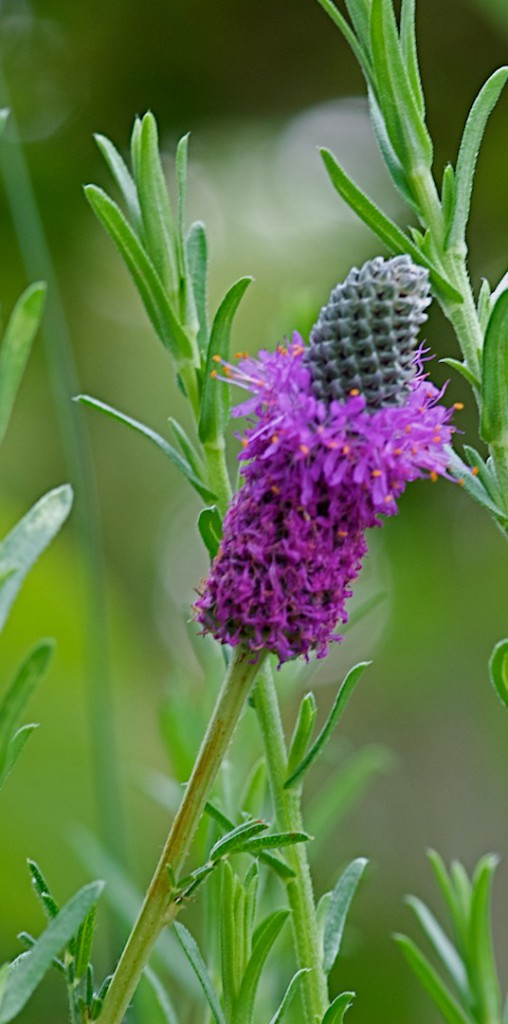
Prairie purple clover flower close up (Dalea purpurea). Photo by Janice Tucker
Common name: purple prairie clover
Plant Family: Fabaceae (bean)
Article and photos by Janice Tucker
The color purple arrived on the scene when cool, calm blue merged with warm, energetic red. Even though delighted with the results, Mother Nature opted to be judicious in selecting the flowers that are allowed to display the various hues of purple. It’s as if only special blossoms are entitled to assume such a royal mantle. The purple prairie clover (Dalea purpurea) wears this color of honor with dignity and a large helping of gaiety. It spills down hillsides, often mingled with other wildflowers, undulating in the breeze with native grasses in plains and prairies or providing a splash of color in a woodland glade. And if it chooses, it may also show up, uninvited, in a well-tended home garden. If that happens, invite it to stay.
Native to North America in the central provinces of Canada and a large part of the United States, the perennial purple prairie clover thrives in elevations of 4,000 to 7,500 feet. Its colorful presence is heartily welcomed by plant aficionados who live in dry, and often windswept environments such as the steppe climate of the Santa Fe area. The purple prairie clover is included in the Santa Fe Botanical Garden’s plant collection inventory for the Botanical Garden at Museum Hill. Its purple spikes mingle with other blooming native plants in the Sunrise Discovery Garden of the ethnobotanical Ojos y Manos: Eyes and Hands Garden.
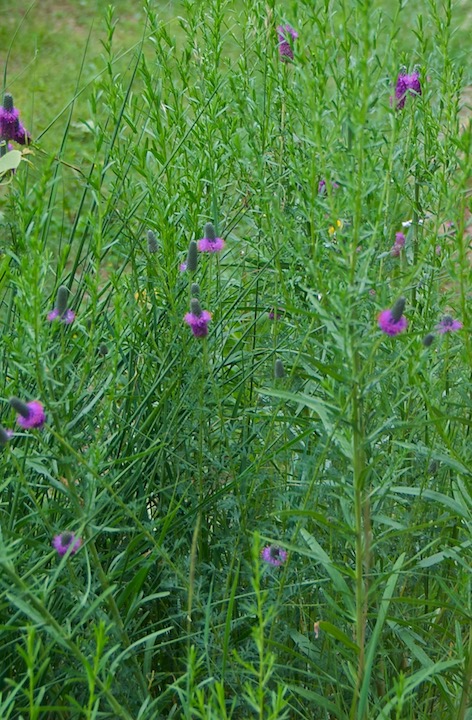
Purple prairie clover. Photo by Janice Tucker
The purple prairie clover reveals its penchant for playfulness even with the slightest puff of air. The cylindrical spikes packed with multiple, tiny, purple flowers embellished by protruding, over-achieving yellow-orange stamens pirouette like miniature ballerinas atop agile branches as they sway in the breeze. Small, odd-pinnate leaves cloak the stems and branches with their fringe-like, lush, green foliage, adding to the charm of this colorful animation. Flowering continues from late spring into autumn. Its sweet nectar satisfies the appetites of bees and butterflies. The fruits are half-inch pods that hold 1 to 2 seeds each. The bare flower spikes lend a subdued, textured beauty to the autumn landscape. The deep, woody taproot combined with near-surface, lateral roots are less glamorous than the dramatic flora above ground but serve as workhorses to provide nutrients and moisture as well as protection from drought and frigid winter temperatures. The taproot’s depth also ensures that the plant remains firmly anchored as a safeguard against high winds and/or erosion.
It is not unusual for the purple prairie clover to volunteer in a sunny area of a garden, usually turning up alongside native grasses, penstemons, asters, Mexican hats, gaillardias or other perennials and annuals. What a gift! If permitted to bloom where it is planted, the purple prairie clover will most likely continue to bless the area with purple flowers every year. Digging up that tough taproot of 6.5 feet may be more labor intensive than any gardener wishes to tackle, and it probably would not transplant very well. Hardy in USDA Zones 3-8, the purple prairie clover can be introduced in the garden as a bedding plant or by seeds, both available commercially.
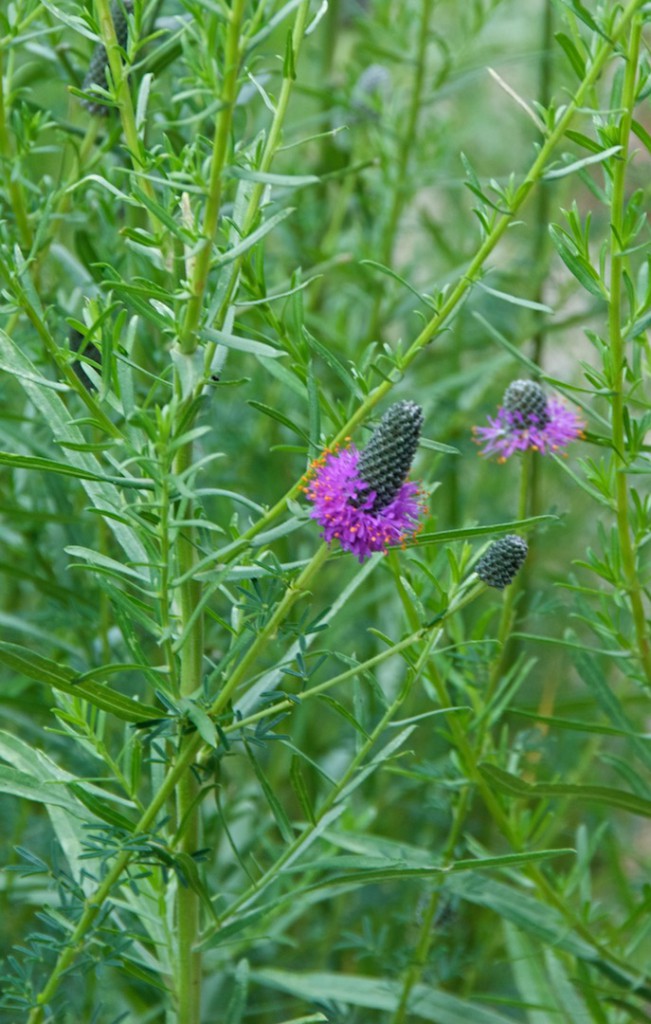
Purple prairie clover stems, leaves, and flowers. Photo by Janice Tucker.
Be sure to select a sunny location since it will refuse to grow in shade. It is not picky about soil as long as it drains well. Seeds should be stratified for about 3 months (it’s okay to store them in refrigerator during that time) and the outer seed surface should be roughed up (scarified) prior to planting. Cover the seeds with about 1/16 inch of soil and water gently. Continue to keep the area moist but not soggy until the seeds have sprouted, which should occur in 14 to 30 days. Once established, the purple prairie clover usually does not need supplemental water.
The purple prairie clover is tailor-made for the laid-back gardener. This deciduous subshrub grows to a maximum height of 3 feet and a width of 1.5 feet, which is a versatile, compact size that performs well in plant groupings, along borders, in rock gardens, and even in the vegetable garden for a pop of color. And it naturalizes as it is prone to do in its natural habitat. The purple prairie clover needs very little, if any, maintenance. Like other species in the Fabaceae (bean) family, the purple prairie clover pays its own way by fixing nitrogen in the soil, eliminating the need for fertilizer. Since it is not bedeviled with plant diseases and pests, forget about herbicides and pesticides. Unlike many other plants, the seeds are neither borne by the wind nor spread by clinging to animal fur…or your socks and pants. If allowing plants to reseed are part of your gardening practices, avoid deadheading the spent flower spikes. Let them remain in order to allow mature seeds to drop and germinate near the parent plant.
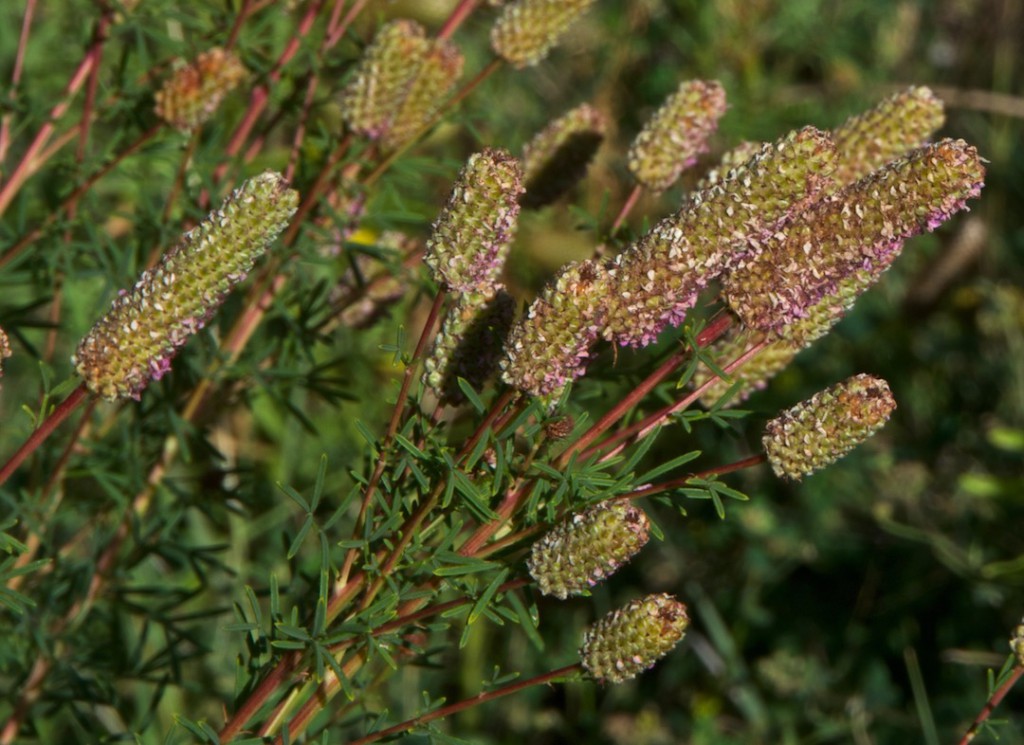
While the purple prairie clover is often chosen for landscape purposes, it provides many other benefits. Ranchers allow their livestock to graze in fields of the palatable and nutritious purple prairie clover. However, this practice needs to be monitored since overgrazing will eventually kill it. Although cattle and some wildlife enjoy browsing on this plant, deer tend to opt for other offerings they seem to find more delectable. The seeds are a food source for birds and small mammals. But since ingested seeds are reported to have a low viability, critters most likely do not assist in spreading purple prairie clover. The purple prairie clover is often added into a mix of grasses and other wildflower seeds to restore fields and slopes that have been at the mercy of erosion. And, thanks to bees, there is the sweet gift of honey bestowed by the purple prairie clover that allows us to engage our sense of taste in addition to our sense of sight.
The purple prairie clover (Dalea purpurea) holds a place in American history as one of the plant species collected during the Lewis and Clark Expedition (1804-1806). French botanist, Étienne Pierre Ventenat (1757–1808) named the plant Dalea purpurea in honor of the English botanist, Samuel Dale (1659-1739). The scientific name was changed to Petalostemon purpureum by the renowned American botanist, Asa Gray (1810-1888). But it seems that the current, accepted scientific name has boomeranged back to Dalea purpurea. The specific Latin names of purpurea and purpureum convey the same meaning for the adjective of color purple; the female and male forms match the ending of the genus name. But wait, there’s more. The common name, purple prairie clover? It’s not really a clover. Ach! Plant names!
In her book, The Color Purple, Alice Waters describes a conversation between the characters, Shug and Ceile. Shug tells Celie that people need to appreciate the little things that God does to demonstrate love, and that we should take the time to notice them. Shug’s remark to Celie – slightly paraphrased- is: I think it ticks God off if you walk by the color purple in a field somewhere and don’t notice it.
So take time to notice purple flowers. We don’t want to tick off the Almighty.
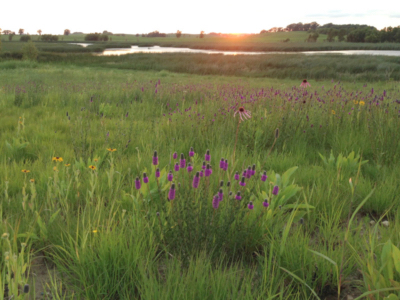
Dalea-purpurea-Purple-Prairie-Clover Dustin Demmer Blazing Star Gardens LLC.
Thanks to Helen Woody and Jeanne Gozigian for proofreading this article.
Sources consulted and/or cited:
Blazing Star Gardens, Owatonna, Minnesota website – permission to use photograph entitled: Dalea-purpurea- Purple-Prairie-Clover Dustin Demmer Blazing Star Gardens LLC.
Bourn Creative website – https://www.bourncreative.com/meaning-of-the-color-purple/,
Meaning of the Color Purple.
Dave’s Garden website, Botanary.
Grant, Bonnie L., Gardening Know How website, Prairie Clover Information: Growing Purple Prairie Clover in the Garden.
High Country Gardens website, Dalea purpurea Seeds/Purple Prairie Clover Seeds.
JSTOR website – plants.justor.org, Global Plants, Dale, Samuel (1659-1739)
Lady Bird Johnson Wildflower Center website, Dalea purpurea.
Littlefield, Larry J. and Burns, Pearl M., Wildflowers of the Northern and Central Mountains of New Mexico.
National Audubon Society Field Guide to Wildflowers, Western Region.
SEINet-Arizona – New Mexico Chapter website, Dalea purpurea Vent., Field Guide notes.
Stearn, William T., Stearn’s Dictionary of Plant Names for Gardeners.
USDA Fire Effects Information System (FEIS) website, Dalea purpurea.
The Plant List website, Dalea purpurea.
- S. National Plant Germplasm System website, Dalea purpurea Vent.
United States Department of Agriculture Natural Resources Conservation Service Plant Fact Sheet website, Purple Prairie Clover – Dalea purpurea Vent. var. purpurea.
Waters, Alice, The Color Purple.
Wikipedia website –List of species described by the Lewis and Clark Expedition.
Wikipedia websites for information on botanists, Ventenat, and Gray.


